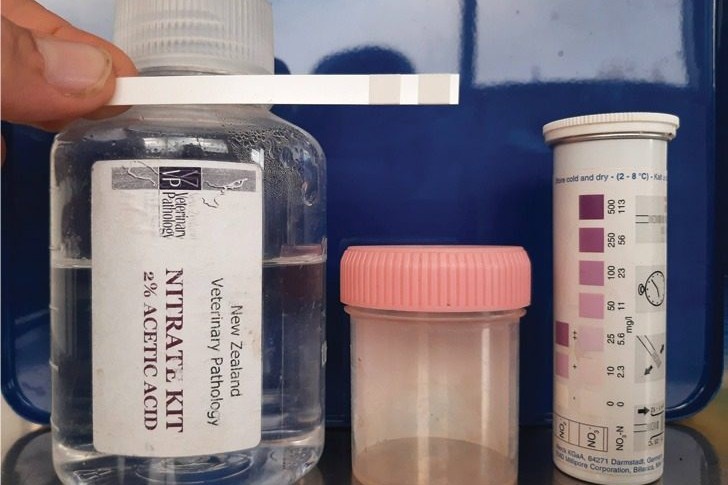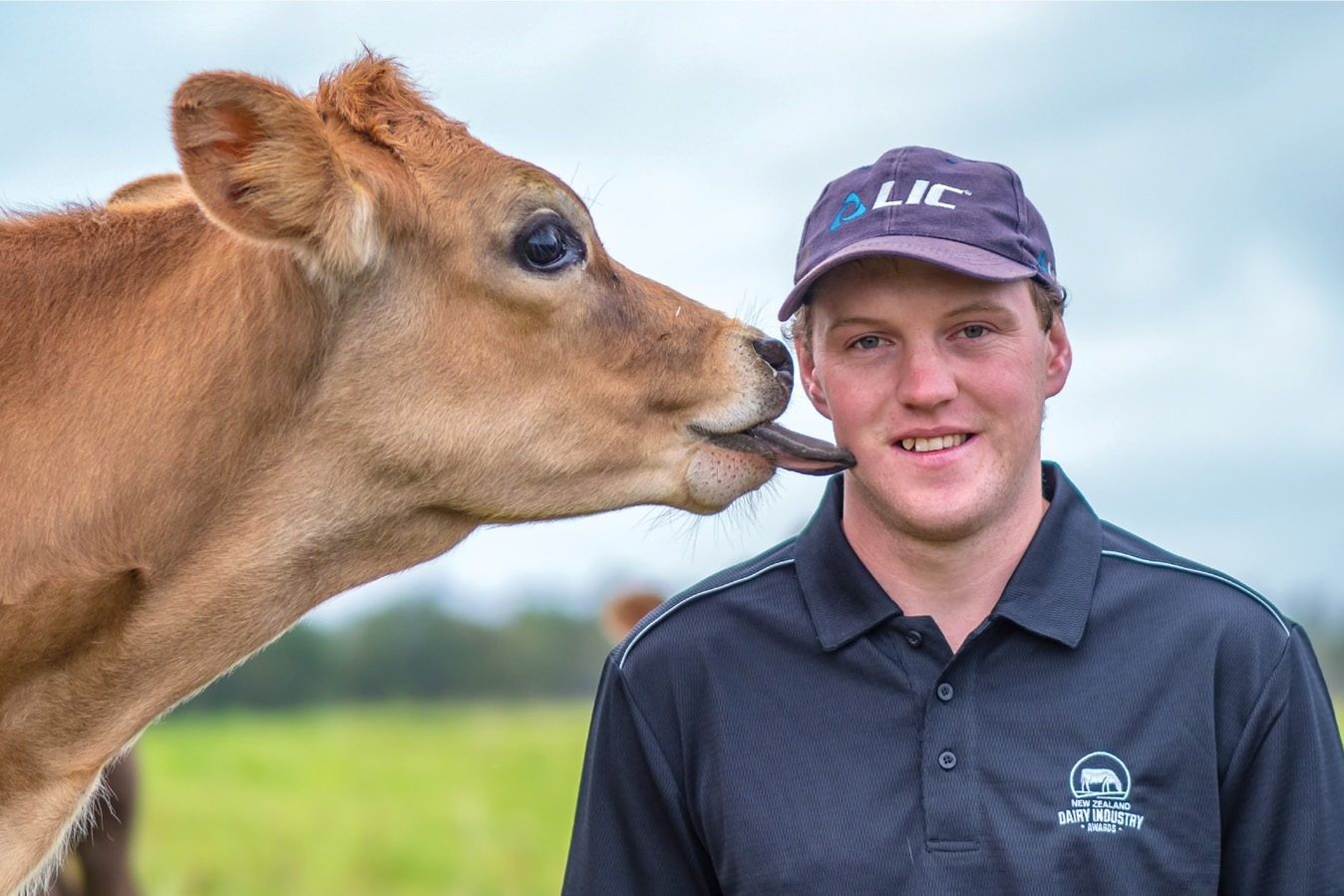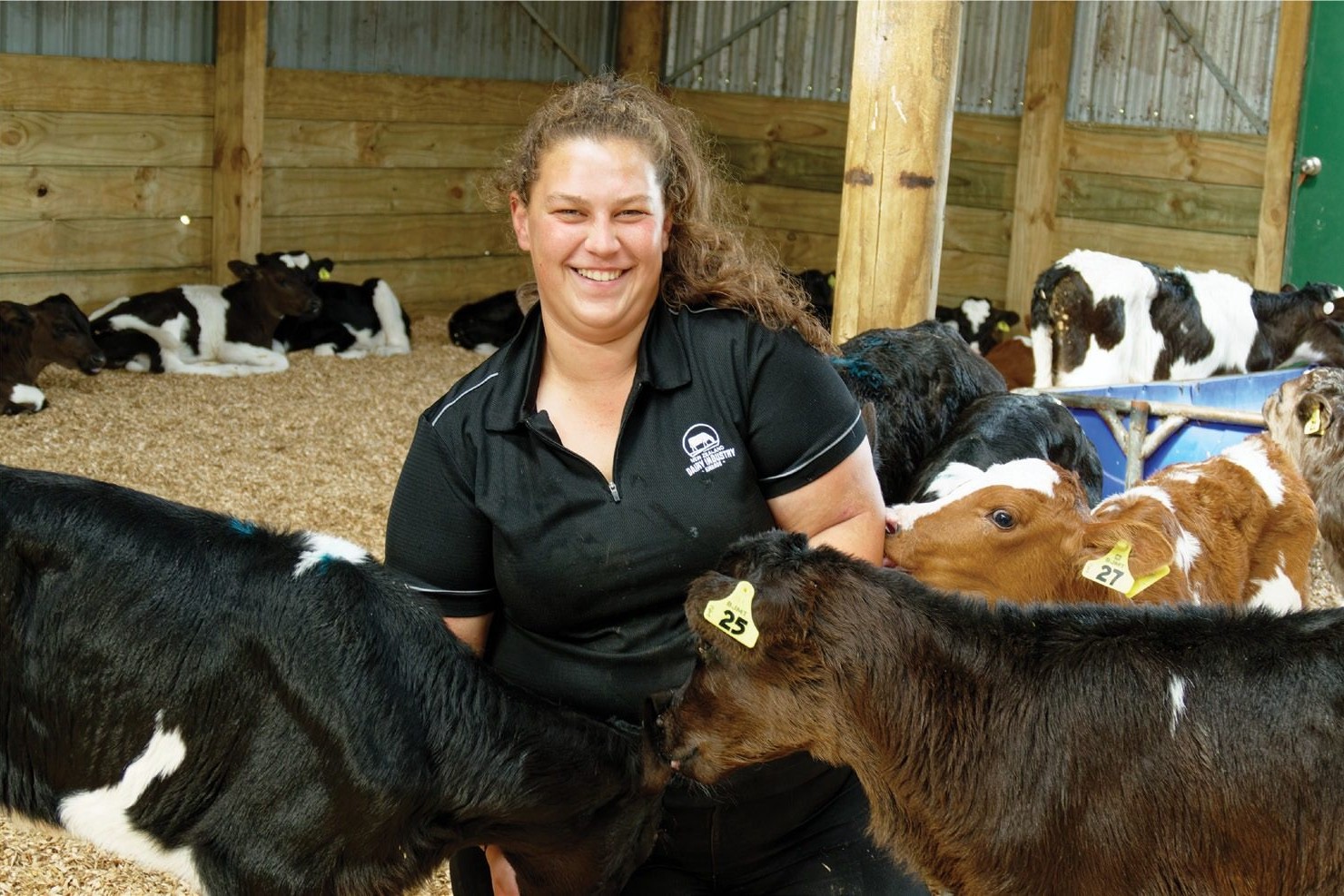Kintore Farm equity managers Nick and Melz Hoogeveen are using beef genetics from a variety of breeds to improve stock and reduce the number of bobby calves going to the freezing works. Sandra Taylor reports. Photos: Johnny Houston.
Bobby calves have been accepted as a necessary byproduct of the New Zealand dairy industry for generations but times are changing.
Nick and Melz Hoogeveen are equity managers on Mid Canterbury’s Kintore Farm, a self-contained 1550 cow operation spread over 1064ha at Carew.
Three years ago, the couple began to consider their options to try and reduce the number of bobby calves they were sending away for processing every year.
It was a staff member Trudy Bensted who was passionate about finding a home for every bobby calf – along with Nick’s involvement in the NZ Farming Facebook page – that were the catalysts for change.
Nick says through the social media page, they were gauging public perception about the practice of slaughtering calves at such a young age and knew as an industry, they had to change.
“Farming is not just about the dollars, it’s about the people, the environment and animal welfare, they all need to be taken into consideration.”
Two years ago, the couple dipped their toe in the water by using 25 straws of Speckled Park and Hereford bulls across their non-replacement cows in a bid to lift the value and finishing ability of their calves.
A change of a grazing arrangement also meant they suddenly had the ability to finish the beef cross cattle within their own business so could see what beef genetics worked best for their system.
Nick says as dairy farmers, the most important factor for them to consider when using beef genetics is easy calving.
“They have to be easy on the cow at calving.”
The CowManager system they have on their cows can identify when a cow is likely to have problems calving a few days out due to a drop in drymatter intake, but they also highlight the on-going impact a difficult calving will have on a cow including being late to cycle and get back in calf. From a dairy farmers point of view, they also want short gestation genetics and from a finishers perspective, they want the calves to grow quickly so they are finished to good carcase weights and hit early season premiums.
“So, we need to select short gestation, easy calving, fast growing and early finishing genetics,” says Nick.
The change in practice has made the couple think hard about the genetics they are selecting for use in their herd and last mating, they used high-value beef genetics across 300 cows, a fifty: fifty split of Homozygous Black Hereford and Belgian Blue genetics.

“It’s not just the cow we are looking at, it’s the bull and we need to have the data about the bulls we are using,” says Nick.
Because they used artificial insemination (AI) at mating last spring, they will be able to match the calf with the bull and determine which genetics are performing best in their environment.
Nick admits it does create extra work, but he feels that it is something that, as an industry, they will have to do.
Rearing beef
The beef cross calves are reared with the replacement heifers on whole milk and while they were weaned at 90kg, Melz feels this is too early for the beef calves in their system.
She says they grow so quickly, that they reach 90kg before they are ready to be weaned. This year they won’t wean any calf younger than 10 weeks.
After weaning, the calves stay on meal until they reach 110kg and then all the calves (replacement heifers and the beef cross calves) are run onto Kintore Farm’s run-off blocks.
The R1s winter on fodder beet supplemented with grass baleage to give them that all important protein before being grown out on grass.
Nick says the beef calves (the males are castrated) are run with the bigger dairy heifers over winter simply because they are such aggressive feeders and will out-compete small, lighter dairy heifers.
“They are just eating machines,” says Melz.
“The Belgian Blues have a really good appetite and are protein hungry.”
She believes the fact that they are always eating makes them very quiet and easy to handle.
Their first lot of Speckled Park beef cattle are now prime and will soon be processed. While Nick and Melz have been happy to embrace the shift to using high value beef genetics, Nick says it’s not the total solution to bobby calves as they will always have late calving cows that need small, short gestation, easy calving bulls.
Neither is it a money-making exercise as with current returns, Nick says they will be pleased to make a small profit on top of the cost of production. However, for them, using high quality beef genetics as a way to reduce bobby calves is the right thing to do from an industry point of view. They also enjoy growing out beef animals and take pride in the prime beef cattle they are producing.
“Economically there is not much in it and we would be financially better off growing another crop of cereal, but we need pasture in our crop rotation and we needed to increase the stock numbers for our run-off.”
Biosecurity concerns means they run a closed herd and do not want to buy in or graze any other livestock. He admits the problem in their business is that they are running the beef cross cattle on dairy heifer land and paying dairy heifer rates, which are now out-competing beef production.
Genes are critical
The couple say using the right beef genetics is crucial for them and while they source their beef genetics from Samen, they are pleased that Samen, LIC and B+LNZ are investing in collecting data to identify the animals that will meet the demand of both dairy farmers and finishers. They believe that in the future, the dairy and beef industries will become increasingly integrated and this means a shift in focus away from just milk production.
“I think integration is going to become bigger and bigger.
“Dairy beef has a smaller environmental footprint than beef and we have to utilise that to our benefit,” says Nick.
The most important factor he believes is identifying the right beef bulls to use in the industry to ensure the end result is healthy cows and economic beef animals.
“Farming is not just about the dollars, it’s about the people, the environment and animal welfare, they all need to be taken into consideration.”
Dairy beef progeny test
Work is well underway to identify and enable the widespread use of superior bulls for use in the dairy industry to allow both dairy farmers and finishers to capture the value of well grown dairy beef.
B+LNZ Genetics’ general manager Dan Brier says the aim is to offer easy calving and short gestation length genetics to dairy farmers while finishers still benefit from fast finishing animals with superior carcase attributes.
Dan says a recent study comparing the climate footprint of dairy beef with traditional beef systems was interesting and provided some pointers on where the dairy and beef industries could work together further.
“By identifying the right beef genetics to use across our dairy herds, dairy farmers, finishers, processors and the environment will all benefit.”
Bulls tested to date have not caused significant calving difficulty in the crossbred cows they were mated to, indicating that there is a substantial pool of bulls available that could be used with confidence over dairy cows. It is important to use beef bulls with estimated breeding values (EBVs) where possible to ensure there is less risk of calving problems.
A PhD student who looked at the dairy farm impacts of using beef bulls in the B+LNZ Genetics Dairy Beef Progeny Test at Limestone Downs (the original Dairy Beef Progeny Test farm – now at Renown, Wairakei Estate) reported no effect on milk production or rebreeding performance for cows that calved to different beef bulls.
Within 101 bulls tested between 2016 and 2019, gestation length had a range of 13 days. This has the potential to add value for dairy farmers, especially where the bulls were used later in the mating period. A shorter gestation will bring a late calver back towards the mean calving date, increasing her chance of conception in the following season.
Of 85 bulls tested between 2016 and 2019, the 600-day weight recorded for their progeny had a range of 67kg. Dan says if the bulls were restricted to a 282-day gestation period or less, the range in 600-day weight was still 61kg.
“This indicates that there is huge opportunity to improve the growth potential of dairy beef calves without having to compromise on calving ease or gestational length.”
Last year, LIC joined forces with B+LNZ Genetics to support the Dairy Beef Progeny Test. Dan says as the co-operative services around 80% of dairy cows on farms across NZ through its artificial breeding programme, this collaboration will ensure that the default beef semen choice of those dairy farmers will produce calves that perform at all stages of the supply chain.
Dan says the option is open for other industry bulls to be entered in the Dairy Beef Progeny Test to allow benchmarking and ensure farmers have access to the best genetics available.
The most recent report from B+LNZ Genetics Dairy Beef Progeny Test can be viewed at dairybeefprogenytest.com
- Supplied by Beef + Lamb New Zealand.





